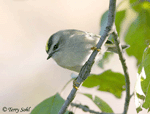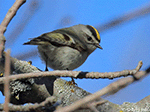Golden-crowned Kinglet
Regulus satrapa
| Length: 4 inches | Wingspan: 6.5 to 7 inches | Seasonality: Winter / Migrant |
| ID Keys: Tiny size, short tail, facial striping, tiny pointed bill, orangish-yellow crown with black border. | ||
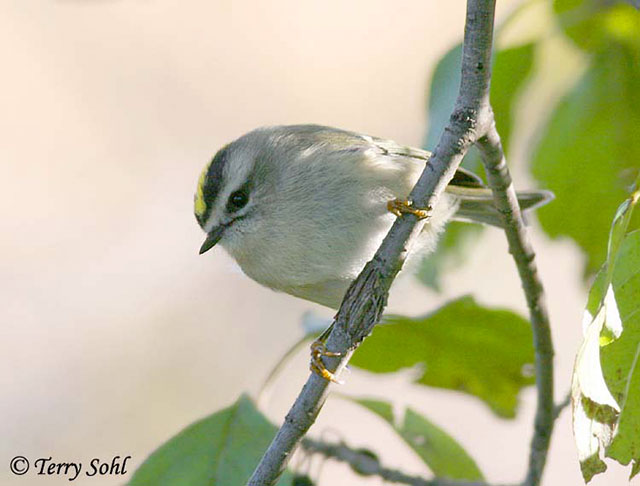 Golden-crowned Kinglets
are among the smallest of birds to be found in the state, but are quite hardy,
being found the most in South Dakota in winter. Inquisitive and sometimes
extremely tame, they will
sometimes allow extremely close approach. During the winter months in the
state, they often are found in mixed foraging flocks which also contain
Black-capped Chickadees, nuthatches, Downy Woodpeckers,
and Brown Creepers.
Golden-crowned Kinglets
are among the smallest of birds to be found in the state, but are quite hardy,
being found the most in South Dakota in winter. Inquisitive and sometimes
extremely tame, they will
sometimes allow extremely close approach. During the winter months in the
state, they often are found in mixed foraging flocks which also contain
Black-capped Chickadees, nuthatches, Downy Woodpeckers,
and Brown Creepers.
Habitat:
During the summer breeding season, they are found in dense conifer forests. They are also most commonly found in conifer forests during winter and in migration, but can also occasionally be found in deciduous forests.
Diet:
The majority of the diet is very small insects and spiders, including many insect and spider eggs. They also have been known to feed on sap from sapsucker drill wells, and occasionally on small berries.
Behavior:
Very active when foraging, hopping quickly among branches. Much of their time foraging is spent hanging upside down from the tips of branches. They will also occasionally hover as they pick insects from foliage.
Nesting:
June and July in their normal breeding range. Golden-crowned Kinglets nest relatively high in the tops of conifer trees, placing then nest on a branch from 30 to 75 feet from the ground. The nest itself is a small cup, built primarily of mosses, lichens, and rootlets, and lined with feathers, hair, and bits of bark. The female lays between 5 and 10 eggs, and she alone incubates them, although the male will bring food for her during the incubation period. The young hatch after about 2 weeks, and fledge from the nest 15 to 18 days after hatching. Mating pairs often raise two broods during a single breeding season.
Song:
Song beginning with tse-tse-tse followed by a rapid trill. The alarm call a high-pitched, thin, single tse note.
- Click here to hear the alarm call of a Golden-crowned Kinglet1
- Click here to hear the song of a Golden-crowned Kinglet2
Migration:
Summers throughout much of Canada's conifer forests, along the Pacific Coast of the U.S., conifer forests of the western U.S., and in the northeastern U.S. and northern Appalachians. Winters throughout much of the United States and northern Mexico, with some populations along the Pacific Coast of Canada and the U.S. being permanent residents.
Interactive eBird Map:
Click here to access an interactive eBird map of Golden-crowned Kinglet sightings
Similar Species:
If seen well, Golden-crowned Kinglets are relatively easy to identify. The most obvious bird that might cause an identification challenge is the other kinglet species we have in North America, the Ruby-crowned Kinglet. Both species do have very similar plumage on the body, with light grayish underparts often tinged with yellowish or olive tones, dark wings with yellowish edging, and a olive-gray back. The "crown" color is clearly a difference, as Golden-crowned Kinglets do indeed have a yellow crown stripe, while Ruby-crowned Kinglets have a red one. Note the yellow crown on a Golden-crowned Kinglet is typically visible, while that of a Ruby-crowned Kinglet is often concealed under olive-colored feathering. Facial patterns between the two kinglet species are also different, with Ruby-crowned Kinglets having an obvious white eye ring, and Golden-crowned Kinglets lacking an eye-ring but having diffuse white and dark striping on the face.
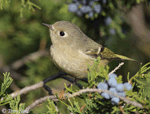 |
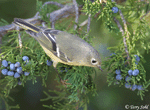 |
 |
| Ruby-crowned Kinglet | Ruby-crowned Kinglet | Ruby-crowned Kinglet |
Conservation Status:
Numbers appear to be stable to increasing, with systematic surveys such as Christmas Bird Count and Breeding Bird Survey showing modest increases in the last several decades in some locations. There are often year-to-year population fluctuations, with declines noted after especially harsh winters. They have also begun to expand their breeding range in some locations, particularly in the Northeast U.S. Overall, they are found across a very broad geographic area, they are common in parts of that range, and overall numbers are strong. The IUCN considers the Golden-crowned Kinglet to be a species of "Least Concern".
Further Information:
- Patuxent Bird Identification InfoCenter, Golden-crowned Kinglet
- WhatBird - Golden-crowned Kinglet
- Audubon Guide - Golden-crowned Kinglet
Photo Information:
October 15th, 2005 -- Atkins Slough in Lincoln County -- Terry Sohl
Additional Photos:
Click on the image chips or text links below for additional, higher-resolution Golden-crowned Kinglet photos.
Audio File Credits:
- 1Steve Hampton. Recorded in Kittitas County, Washington on July 27th, 2018. Original recording and information available from xeno-canto.
- 2Sue Riff. Recorded in Camp Dick, Colorado on June 7th, 2018. Original recording and information available from xeno-canto.
| Click on the range map for a higher-resolution view |
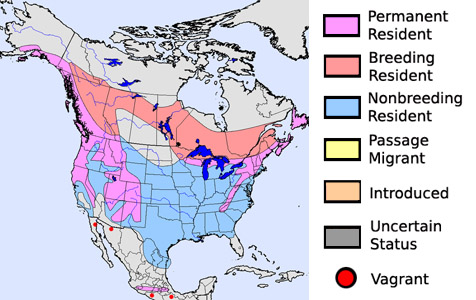 |
| South Dakota Status: Common migrant, uncommon winter visitor statewide. Uncommon permanent resident in the Black Hills. |
Additional Golden-crowned Kinglet Photos
